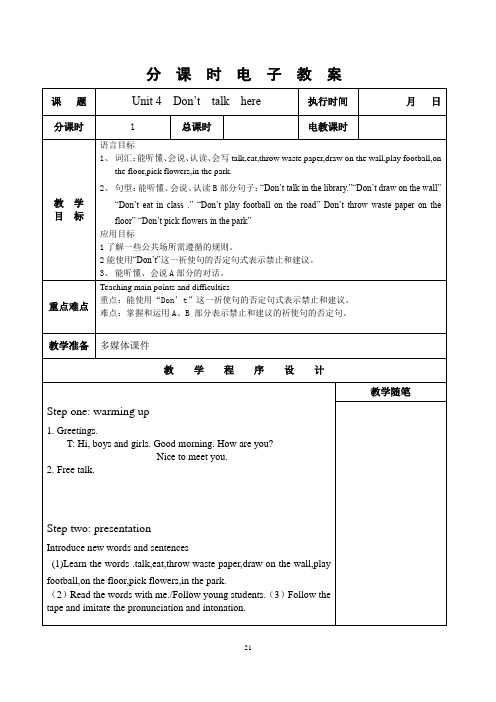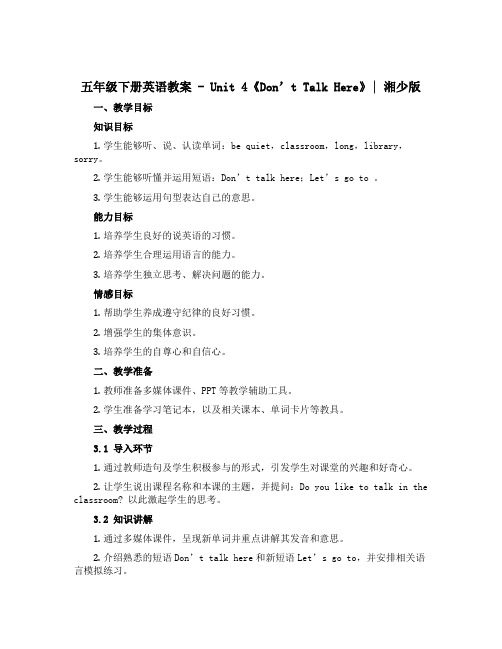Unit4Don'ttalkhere.
五年级下册英语教案-Unit4Don’ttalkhere|湘少版

五年级下册英语教案-Unit 4 Don’t talk here|湘少版教学内容本单元主题为“Don’t talk here”,主要围绕在特定场合下的礼貌用语和行为规范展开。
教学内容包括但不限于:学习基本的禁止句型,如“Don’t talk here”, “Don’t run in the classroom”;了解在不同场合下的行为规范,如图书馆、教室等;通过角色扮演等方式,提高学生的实际运用能力。
教学目标1. 知识目标:学生能够理解并运用本单元的核心词汇和句型,如“library”, “classroom”, “Don’t talk here”等。
2. 技能目标:通过情景模拟和角色扮演,学生能够在实际情境中恰当使用禁止句型,表达禁止或警告的意思。
3. 情感目标:培养学生遵守公共规则和尊重他人的意识,增强其在不同社交场合的适应能力。
教学难点1. 词汇记忆:本单元涉及多个特定场合的英语表达,学生需要准确记忆并区分。
2. 句型运用:正确使用禁止句型,理解其语气和语境。
3. 文化差异:理解中英文化在公共场合行为规范上的差异。
教具学具准备1. 多媒体设备:用于播放教学视频和音频材料。
2. 图片卡片:展示不同场合的图片,帮助学生记忆相关词汇。
3. 角色扮演道具:如图书、课桌椅等,用于模拟真实场景。
教学过程1. 导入:通过图片展示不同场合,引导学生思考在这些场合应该遵守的规则。
2. 新授:介绍核心词汇和句型,通过例句和情景模拟帮助学生理解。
3. 练习:进行小组活动,让学生运用所学知识进行角色扮演。
4. 巩固:通过游戏和竞赛形式,巩固学生对词汇和句型的掌握。
板书设计1. 核心词汇:以图表形式展示,便于学生记忆。
2. 句型结构:用不同颜色标出,突出重点。
3. 情景模拟:板书上预留空间,用于展示学生角色扮演的场景。
作业设计1. 书面作业:完成相关词汇和句型的填空、选择等练习。
2. 口头作业:与家长或同伴进行角色扮演,模拟真实场景。
unit4 Don't talk here

T: Do you like summer ? Why ?
Step 3 While-reading
1.初读课文学生快速阅读课文D部分,了解文章大意。完成下列判断
题。
()Bob and Paul study in Sunshine School .
()Bob and Paul are not roommates .
()Bob likes drawing .
()Paul likes singing .
2.听录音,跟读第一段
任务:用短文中的句子解释roommates
3.二读课文
学生再读D部分课文,完成表格。
请在他们各自喜欢的项目下画笑脸
Step 4 homework
教学随笔
板
书
设
计
教
学
反
思
2、句型:能听懂、会说、认读B部分句子:“Don’t talk in the library.”“Don’t draw on the wall” “Don’t eat in class .” “Don’t play football on the road” Don’t throw waste paper on the floor” “Don’t pick flowersin the park”
教
学
反
思
分 课 时 电 子 教 案
课 题
Unit 4 Don’t talk here
执行时间
月 日
分课时
2
总课时
电教课时
教 学 目 标
语言目标 词汇;巩固第一课时所学的词汇。
句型:能使用“Don’t”这一祈使句的否定句式表示禁止和建议。
Unit 4 Don't talk here.L1导学案

Unit 4 Don’t Talk Here - L1导学案课前预习本单元的主题是“不要在这里说话”,你可以先思考以下问题:1.为什么有些场所不允许说话?2.在哪些场所你应该保持安静?3.你觉得在说话的音量和内容方面,什么是应该遵守的规则?课堂导入老师可以先介绍本单元的主题、学习目标和重点难点。
之后可以设计如下的活动:1.学生分组,每个小组得到一个场景,如图书馆、博物馆、电影院等。
小组需要讨论,这些场所不允许说话的原因是什么?他们应该如何保持安静?每个小组需要向全班介绍他们的理解和想法。
2.老师根据学生的反馈,带领全班总结出规则和原则。
可以问学生,在什么情况下可以说一些话?在什么情况下必须保持安静?学习重点和难点重点1.学会用英语表达“不要在这里说话”;2.学会询问或要求别人保持安静;3.学会描述各种场合下的不同习惯和行为。
难点1.在学会表达之后,如何保持适当的英文环境,让学生可以更好地练习英语;2.如何培养学生观察和总结规则的能力,让他们自己发现和解决问题。
学习建议1.在学习本单元时,可以多观察身边的环境和人行为,思考这些行为背后的原因和规则。
例如,去参观博物馆时,可以留心看看其他游客怎么做,思考这样做的好处和重要性。
2.可以在家和朋友建立英语交流的环境,在需要保持安静的场所时使用英语。
例如在图书馆需要求别人保持安静时,可以使用英语来表达自己的意思。
总结本单元的主题是“不要在这里说话”,学习重点是学会用英语表达“不要在这里说话”、学会要求别人保持安静以及描述各种场合下的不同习惯和行为。
老师可以通过各种活动和训练来帮助学生掌握这些技能,并且要注意教育学生学好英语,并培养学生观察和总结规则的能力。
英语下册Unit4Don’ttalkhere第1课时教案湘少版

Unit 4 Don’t talk here第一课时B Let’s Learn A Let’s Listen and Say1.会说会认会写新单词及词组library,throw,waste paper,pick;能听懂、会说、会运用on the wall,on the floor,in class,on the road,in the park。
2.掌握Don’t的用法。
能用祈使句的否定句式“Don’t…”表示禁止和建议。
能熟练掌握和运用A、B部分表示禁止和建议的祈使句。
课件、多媒体、录音机和磁带。
Step 1 Warmup & Revision1.复习上册Unit 10祈使句:Do not pick flowers/go fishing/spit/…2.师生自由对话。
T: What are you going to do this weekend?A: I’m going to read books at home.B: I’m going to play football.C: I’m going to see a film....Step 2 Presentation & PracticeB Let’s Learn1.教师课件展示本部分第一幅图片,问:Where are they? What are they doing? 引导学生回答:They are in the library. They are talking in the library.T: Are they right?Ss: No, they aren’t.T: What do you want to say to them?Ss: Don’t talk in the library.教师板书句子Don’t talk in the library并带读,以同样的方式教授句子:Don’t eat in class. Don’t draw on the wall.2.课件展示第三幅图,说:Look!The boy is throwing waste paper on the floor. 教师板书throw,waste,paper并带读,帮助学生理解句意,教师问:What should we say to him?引导学生说出句子:Don’t throw w aste paper on the floor.教师板书句子并带读句子。
五年级下册英语教案 -unit 4《Don’t talk here》|湘少版

五年级下册英语教案 - Unit 4《Don’t Talk Here》| 湘少版一、教学目标知识目标1.学生能够听、说、认读单词:be quiet,classroom,long,library,sorry。
2.学生能够听懂并运用短语:Don’t talk here;Let’s go to 。
3.学生能够运用句型表达自己的意思。
能力目标1.培养学生良好的说英语的习惯。
2.培养学生合理运用语言的能力。
3.培养学生独立思考、解决问题的能力。
情感目标1.帮助学生养成遵守纪律的良好习惯。
2.增强学生的集体意识。
3.培养学生的自尊心和自信心。
二、教学准备1.教师准备多媒体课件、PPT等教学辅助工具。
2.学生准备学习笔记本,以及相关课本、单词卡片等教具。
三、教学过程3.1 导入环节1.通过教师造句及学生积极参与的形式,引发学生对课堂的兴趣和好奇心。
2.让学生说出课程名称和本课的主题,并提问:Do you like to talk in the classroom? 以此激起学生的思考。
3.2 知识讲解1.通过多媒体课件,呈现新单词并重点讲解其发音和意思。
2.介绍熟悉的短语Don’t talk here和新短语Let’s go to,并安排相关语言模拟练习。
3.3 学生表演学生分组进行表演,以锻炼学生的语言表达能力。
其中,分角色讨论,模拟在教室、图书馆、操场和餐厅等不同场景中如何使用这些新的短语和单词。
3.4 互动交流通过师生互动交流、小组交流等形式,让学生在交流中获得实际语言练习的机会,以不断提高学生的语言水平和应用能力。
3.5 总结回顾对本节课内容进行总结,巩固学生对新单词和句型的理解与记忆。
同时,让学生分享本节课的收获与感想,并引导学生通过反思,反思自己的不足之处。
四、作业布置1.让学生背诵课堂重点内容。
2.布置做英语练习册的练习题目,巩固学生的所学知识。
五、教学反思本节英语课,教育的主要目标是让学生通过语言表达来传达自己的意见,从而锻炼他们的语言表达能力。
Unit4Don'ttalkhere

Unit4 Don’t talk here.一、教材分析(Teaching Material)本单元主要围绕学习一些公共场所需要遵循的规则展开。
通过本课的学习,学生能使用don’t...向他人表示禁止与建议,能够结合生活、学习实际,为图书馆、电脑室、游泳馆等场所制定制度或使用规则,有创意的设计公共场所图标,并能用英语进行口头和书面表达。
动词及动词短语是学生能正确使用don’t这一祈使句否定形式的基础,本单元出现的动词及动词短语talk、eat、write、draw、play football、throw、pick在四年级及五年级上册已有所接触了解。
并且在五年级上册Don’t...这一句型在五年级上册第十单元中已经初步接触过。
二、教学目标(Teaching Aims)1、能听懂、会说、认读、会写talk/eat/throw waste paper/draw on the wall/play football/on the road/on the floor/pick flowers/in the park.2、句型:能听懂、会说、认读B部分的句子。
3、了解一些公共场所需遵循的规则,能使用Don’t向他人表示建议或禁止。
三、教学重难点(Important & Difficult Points)1、重点:能用Don’t...这一祈使句的否定句式表示建议和禁止。
2、难点:能区别Do not/Don’t+动词原形和No+动词ing形式,以及No+名词句式的用法;能熟练运用所学的表示建议和禁止的句型,根据具体的生活环境进行运用。
四、课时安排(Periods Arrangement)三到四个课时五、教具(Teaching Aids)图片、卡片、CD、课件等等。
Unit4 Don’t talk here.Period 1Step 1 Warm-up1.Greetings.2.Chant: use the computer to play the rhythm and Ss chant with it. What, what, what are you going to do?Read, read, we’re going to read.Home, home, we’re going to read at home.What, what, what are you going to do?Play, play, we’re going to play.Park, park, we’re going to play in the park.Chanting helps Ss review the senttence structure of be going to in unit 1 and 2 and also prepares Ss for the studying of part A.Step 2 Presentation1.Guessing game:A S picks a verb card and does the action on the card. The rest of the Ss have to guess the spelling of the action: wrtie? Draw? Play football? This game aims to practice and consolidate the usage of the verbs andverbal phrases like eat/write/draw/play football/pick flowers/write on the book and so on.2.New words and expressions(1)library, reading roomUse the PPT to show Ss part of the pictures of a library and a reading room and have Ss guess where is this place according to the pictures. Teach reading room in the same way.(2)Don’t talk in the library.Don’t talk in the reading room.Don’t talk here.Present Ss the sign of “No talking”. By doing the exact actions and looking at the picture, let the Ss guess the meaning and be able to say the sentence.(3)Don’t throw waste paper on the floor.By showing them a real waste paper to let them get the meaning of the phrase ‘waste paper’. Then do the action of throwing things to help Ss to understand the word ‘throw’.(4)Use the PPT to show pictures of part B and let Ss try to make the sentences that of the same meaning of the pictures.(5)Listen to the tape and read after it.3.The dialogue(1)listen and cross.Present several sentences that related to the dialogue and cross the sentences which don’t occur in the dialogue.Don’t talk here.Don’t eat in the library.Don’t draw on the book.Don’t write on the book.(2)listen and find.Ss open their books and listen to the tape to underline the sentences that means forbidding and suggesting. Then check their answers.(3)Listen and repeat.(4)Read and act.Step 3 Practice.1.Picture game.The teacher shows the Ss the 6 pictures of part B and Ss try to say out these sentences fast.2.Work in groups of 4. One of the Ss say a sentence at a time and the rest of the Ss pick out the pictures very quickly and try to say out the sentence.Step 4 Act and play1.Practice the conversation in part A and try to act it out.2.The teacher offers Ss certain situation and let Ss make their own conversation.Situation 1: In the classroom.Situation 2: In the cinema.Situation 3: In the park.Step 5 Homework1.Listen to the tape and read after the tape.Period 2Step 1 Revision1.Greetings.2.Look at the pictures of part B on the PPT. Then say out the right sentence.3.Make a situation and have 2 pairs of Ss to show their conversation. Step 2 Pre-reading1.Ask and answer between the teacher and Ss.T: I like reading. What do you like?S1: I like drawing/...T: Do you like swimming?S1: Yes, I like swimming./No, I like singing. / ...2.Talk about their favorite season.T: Do you like summer? Why?Try to teach them the usage of because.Step 3 While-reading1.Read the text for the first time.Go through part D very quickly to get the general meaning of the passage. Then finish the following judgments.( )Bob and Paul study in Sunshine School.( )Bob and Paul are not roommates.( )Bob likes drawing.( )Paul likes singing.2.Listen to the tape and read the 1st paragraph.3.Read the passage again and finish the form.Name music drawing reading singing BobPaulStep 4 After-reading1.Ask Ss to play Bob and Paul and share their annoyance.2.Ask Ss to give Bob and Paul advice.Step 5 Homework1.Collect the common sign in daily life.Period 3Step 1 warm-up1.Greetings.2.A guessing game.The teacher draws a picture on the blackboard and has the Ss to guess and express the meaning in English.(This part is designed to review the usage of ‘Don’t...’.)Step 2 Presentation1.Homework checking.2.Make the class rules together.Step 4 Let’s have fun.1.The teacher shows Ss the warning signs and Ss guess their meanings.2.Present the rule sentences in part F and ask Ss try to read them in different forms.3.I can read.Ss choose one rule and do the action while reading.4.I can draw.Draw signs.Step 5 Homework1.Finish the exercise of unit 4.。
五年级英语下册Unit4《Don’ttalkhere》 优秀课件3(新版)湘少版

Unit 4 Don’t talk here
不要在这里说话
library
图书馆
Don't talk in the library 不要在图书馆说话
Don't eat in class 不要在课堂上吃东西
Don't throw waste paper on the fl,朝着梦想 的方向迈进,并且毫不畏惧 地,过着我理想中的生活, 成功,会在不期然间忽然降 临!
1有了坚定的意志,就等于给双 脚添了一对翅膀。 2一个人的价值在于他的才华, 而不在他的衣饰。 3生活就像海洋,只有意志坚强 的人,才能到达彼岸。 4、鸟欲高飞先振翅,人求上进 先读书。
Don't draw on the wall 不要在墙上画画
Don't play football on the road
不要在马路上踢足球
Don't pick flowers in the park 不要在公园里摘花
talk in the library.
Don't
不要
在图书馆说话。 eat in class. 在课堂上吃东西。
Unit 4 Don't talk here.L2说课稿

Unit 4 Don’t talk here. L2 说课稿教学目标1.通过学习本课内容,提高学生的听力水平和口语表达能力;2.学生能够听懂并正确使用本课所涉及的日常用语表达“不要在此说话”;3.通过不同方式的听力训练,帮助学生更好地理解并掌握英语语音和语调。
教学内容1.本课程是旨在帮助学生了解并运用表达“不要在此说话”这一日常用语;2.学生将通过听力练习、小组讨论以及角色扮演等多种形式来加深对所学内容的理解和掌握;3.教学重点将放在学生对英语语音和语调的理解和运用上。
教学方法1.基于任务型教学法的教学理念,注重帮助学生在日常真实场景下提高语言交流能力;2.将使用多种教具,如PPT、录音、视频等,来帮助学生更好地理解和运用所学内容;3.将通过角色扮演和小组讨论等形式的活动来增强学生的兴趣和参与度。
教学过程1. 准备工作•整理教材、PPT等教具;•确保实验室的设备和网路正常运作;•预先录制所需语音和视频,以便在上课时调用。
2. 课堂导入1.师生互动。
老师与学生进行简单的交流,了解学生的英语水平和基本语言能力;2.使用视频或图片等教具,引导学生进入本堂课的主题;3.预习课程内容,让学生了解所需掌握的重点和难点。
3. 实验操作第一部分:听力训练•播放所需录音或视频,让学生跟读和模仿;•组织师生互动,进行简短的口语训练。
第二部分:小组讨论•分组讨论,让学生彼此交流所学内容;•组织师生互动,进行简短的口语训练。
第三部分:角色扮演•组织学生进行角色扮演,模拟真实场景;•督促学生正确运用所需词汇和语调;•教师进行评价,给予建议和指导。
4. 课堂总结•教师总结上述内容,帮助学生理清所学内容的重点和难点;•回顾学生在本堂课中所取得的进步和提高;•鼓励学生在日常生活中运用所学知识,并为下堂课做好准备。
课后作业1.学生回顾本堂课所学内容,整理笔记;2.完成相关练习,如听力、阅读和口语练习等;3.设计并录制一段短视频,介绍自己的学习经历和感受。
- 1、下载文档前请自行甄别文档内容的完整性,平台不提供额外的编辑、内容补充、找答案等附加服务。
- 2、"仅部分预览"的文档,不可在线预览部分如存在完整性等问题,可反馈申请退款(可完整预览的文档不适用该条件!)。
- 3、如文档侵犯您的权益,请联系客服反馈,我们会尽快为您处理(人工客服工作时间:9:00-18:30)。
Don't throw waste paper on the floor.
draw
wall
墙
×
Don't draw on the wall.
play football
× road 道路
Don't play football on the road.
pick flowers
×
park
公园
Don't pick flowers in the park.
Do not smoke.
What does that sign mean?
Do not spit.
talk
library
图书馆
×
Don't talk in the library.
eat
class
×
Don't eat in class.
throw waste paper
扔废纸
floor
地板
A. library B. classroom C. school
二、单项选择。
( B ) 1. ____ talk in class.
A. Not B. Don't C. Can't
( C ) 2. Dongdong is going to ____ on the book.
A. writes B. writing C. write
Play a game: Quick response
Play a game: Quick response
Play a game: Qu game: Quick response
Play a game: Quick response
Play a game: Quick response
湘少版(三起点) 五年级下册
Unit 4 Don't talk here
Part A&Part B
道县第五小学 蒋娟芝
Let's sing together
Talking, talking, talking, talking. Draw, draw, draw, draw, draw, draw. Running, running, running. Running, running, running. Now let's stop, now let's stop!
Make sentences with “Don't...”
Don't...
一、看图选词。
( C ) 1.
A. take B. draw C. throw
( A ) 2.
A. road B. park C. floor
( C ) 3. ( B ) 4. ( A ) 5.
A. home B. zoo C. park A. paper B. floor C. book
What does that sign mean?
Do not use a mobile phone.
What does that sign mean?
Do not talk.
What does that sign mean?
Do not fish.
What does that sign mean?
( A ) 3. Don't ____ on the wall.
A. draw B. to draw C. drawing
( C ) 4. Don't pick ____ in the park.
A. ball B. paper C. flowers
Homework:
1. Listen and repeat Part A & Part B. 2. Make 5 sentences with “Don't...”.
